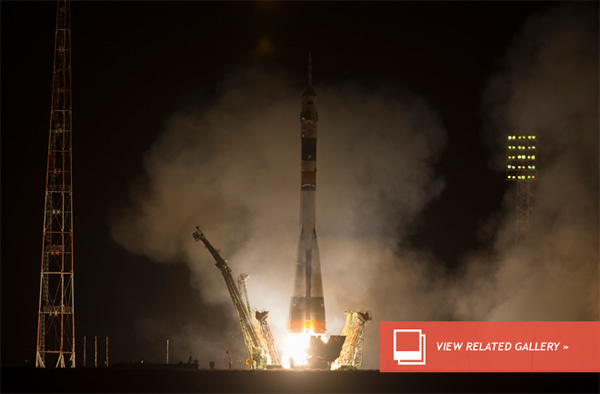Lift Off: Soyuz Takes the Space Station Express Lane
Two Russian cosmonauts and NASA astronaut Chris Cassidy blasted off aboard a Russian Soyuz rocket on Thursday and headed toward the International Space Station, a trip that is expected to take less than six hours, compared to the usual two-day voyage.
Launch from the Baikonur Cosmodrome in Kazakhstan occurred at 4:43 p.m. EDT. Docking is slated for 10:32 p.m.
The trip in the express lane was three years in the making.
“At first everybody was really apprehensive about it, but later on our ballistic specialists calculated the possibility, looked at the rocket and verified the capabilities of the Soyuz (capsule) which now has a digital command and control system and an onboard computer that can do pretty much anything,” incoming station commander Pavel Vinogradov, speaking through a translator, told reporters at a pre-launch press conference broadcast on NASA Television.
Russia conducted three test flights with Progress cargo ships before clearing the Soyuz capsule carrying people to attempt the short-cut.
Lift Off: Soyuz Takes the Space Station Express Lane
The route requires not only precision timing for launch, but a very exacting series of maneuvering burns to catch up to the space station in just four orbits. The usual trip to the station, which flies about 250 miles above Earth, unfolds over 34 orbits.
“In reality, it’s not very far to the space station, although with the velocities we’re talking about, it’s quite an achievement,” deputy station program manager Kirk Shireman said during a NASA interview.
If any problems develop, flight controllers can waive off the expedited schedule and retarget docking at the station for Saturday.
“We’ll try it … with this crew. There are lots of things to learn and understand and then make a decision with subsequent flights whether we’ll do the four-orbit rendezvous,” Shireman said.
Meanwhile, Russian engineers already are looking into cutting the trip time to two orbits, Vinogradov said.
Aside from less time spent in the Soyuz’s extremely cramped quarters, the crew should be able to reach the station before any disquieting impacts of microgravity — nausea, dizziness, vomiting — set in, Vinogradov added.
“For the first four or five hours we are going to be fully operational, without any of the negative side-effects,” he said.
The shorter trip also means biomedical experiments and equipment can reach the station sooner, improving science results.
And then, there’s the ice cream the cosmonauts are bringing as a gift for the three crewmembers already aboard the station.
“Within such a very short period of time, probably the ice cream will not melt,” Vinogradov quipped.
Mar 28, 2013 05:21 PM ET by Irene Klotz












